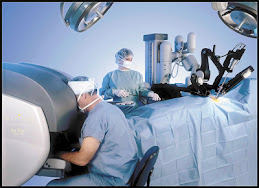http://www.msnbc.msn.com/id/3403901/
Article in CNBC
November 5th, 2005
This article talks about how we have entered the robotic era of surgery and discusses the positive merits of robotic surgery. Introducing the only robotic surgery system currently avaliable on the market, the Da Vinci, the article talks about the many benefits of this system including increased surgical precision and quicker recovery time for patients. Avoiding the massive incisions of traditional “open” operations, the Da Vinci is able to perform surgery by making small incisions the diameter of a pencil and inserting cameras. Doctors are then able to manipulate the robotic arms of the system from a cockpit console displaying 3D video of the operation. The Da Vinci machine has already been used in many surgical procedures including prostate removal, gastric bypass surgery, and to repair the esophagus of chronic heartburn patients. Currently the system is waiting for approval from the FDA for heart bypass surgery.
While the article cites many benefits of the Da Vinci system it also presents some negative aspects of the system. For one the price is not cheap. The purchase price for the machine costs $1 million and this is not including the annual maintenance and training for the system, which amounts to additional hundreds of thousands of dollars each year. Hospitals are hesitant to spend so much money mainly because insurance companies are wondering if the technology is worth it. Do we really need this type of technology? Is it really that great of an advance over our current surgical procedures? Outfitting hospitals in the United States with robotic surgery will costs millions of dollars and will be a recurring cost. As Dr. Wayne Poll, a private practice surgeon, states, “Some of what’s happening in robotics is that it’s sexy… And patients not really knowing the difference- just wanting the most advanced technology.” As with any new technology, the innovation and wow factor amazes us but in the end we have to ask ourselves is the technology necessary and reasonable. The current major problem in the American healthcare system is not the surgical procedures we are performing, it is the millions of Americans that aren’t insured. Should we really be spending our money on new technology that may not be necessary or should we be trying to spend our money on getting the uninsured insured?
Subscribe to:
Post Comments (Atom)

No comments:
Post a Comment